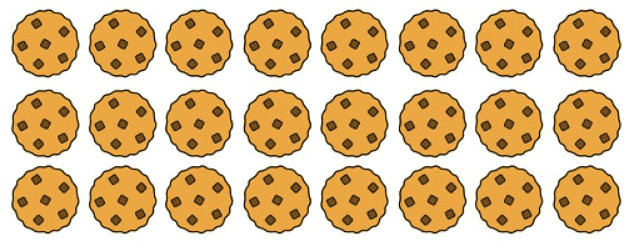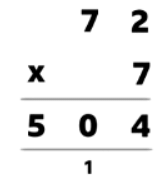Multiply 3 numbers | Year 5 Mathematics PDF Download
Introduction
- Multiplying three numbers can be simplified by breaking down the calculation into stages.
- Utilizing knowledge of times tables can significantly ease the process of multiplying multiple numbers.
Multiplying three numbers
If you can multiply two numbers together, you can extend this to multiply three numbers together.
For example, to solve 3 × 8 × 2 using an array:
Visualize 3 rows of 8 cookies, giving 3 × 8 = 24.
Then multiply this by 2 to find the final answer: 24 × 2 = 48. Therefore:
Therefore:
3 × 8 × 2 = 48
Breaking down the calculation into stages like this can make it much easier.
You don’t always need to rely on arrays to solve multiplication problems involving three numbers. Sometimes, it's quicker and simpler to decide which numbers to multiply first.
Examples
Example: 1
What is 4 x 3 x 7?
Consider which multiplication is easiest to solve first using your times tables knowledge:
4 × 3 × 7 = 12 × 7
or
4 × 3 × 7 = 4 × 21
or
4 × 3 × 7 = 28 × 3
It doesn't matter which order you choose, the final answer will be the same.
Solving 4 × 3 first to get 12 and then multiplying by 7 is likely the easiest to do mentally.
4 × 3 = 12
Then calculate:
12 × 7 = 84
Sometimes it may be challenging to find a times tables link or use an array. In such cases, you can use short multiplication to help you.
Example: 2
What is 8 x 9 x 7?
Whichever numbers you choose to multiply first, you will always end up with a large 2-digit number multiplied by a 1-digit number.
Let’s solve 8 × 9 first:
8 × 9 = 72
Now, let's calculate 72 × 7 using short multiplication:
Here's how you could solve this calculation using short multiplication:
- Multiply 2 x 7 first to make 14.
- Write the 4 in the ones column and carry the 1 into the tens column - you always need to make sure your place value is correct!
- Then solve 70 x 7 = 490. Don’t forget about the extra ten: 490 + 10 = 500.
Therefore: 8 x 9 x 7 = 504
|
45 videos|51 docs|15 tests
|















